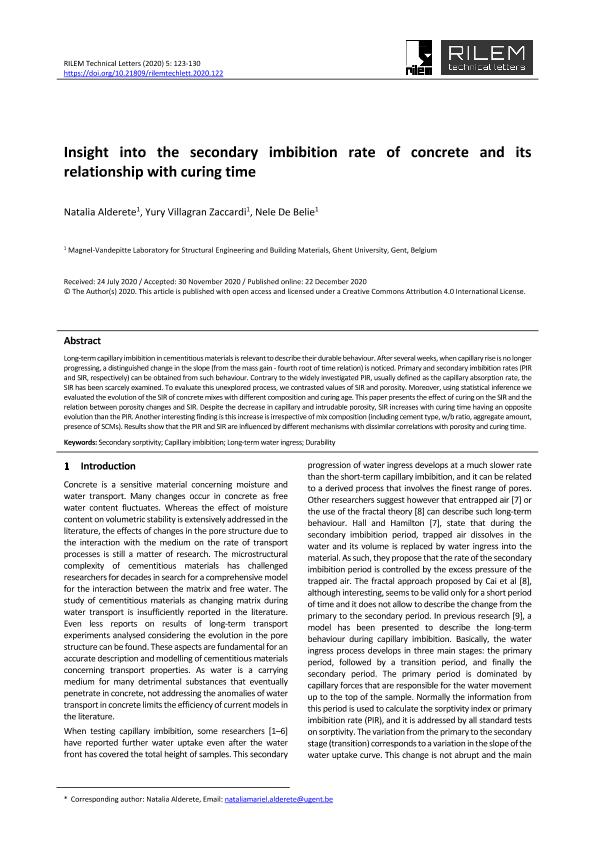Mostrar el registro sencillo del ítem
dc.contributor.author
Alderete, Natalia Mariel

dc.contributor.author
Villagrán Zaccardi, Yury Andrés

dc.contributor.author
de Belie, Nele

dc.date.available
2021-10-25T15:01:10Z
dc.date.issued
2020-12-22
dc.identifier.citation
Alderete, Natalia Mariel; Villagrán Zaccardi, Yury Andrés; de Belie, Nele; Insight into the secondary imbibition rate of concrete and its relationship with curing time; RILEM Publications SARL; RILEM Technical Letters; 5; 22-12-2020; 123-130
dc.identifier.issn
2518-0231
dc.identifier.uri
http://hdl.handle.net/11336/144935
dc.description.abstract
Long‐term capillary imbibition in cementitious materials is relevant to describe their durable behaviour. After several weeks, when capillary rise is no longer progressing, a distinguished change in the slope (from the mass gain ‐ fourth root of time relation) is noticed. Primary and secondary imbibition rates (PIR and SIR, respectively) can be obtained from such behaviour. Contrary to the widely investigated PIR, usually defined as the capillary absorption rate, the SIR has been scarcely examined. To evaluate this unexplored process, we contrasted values of SIR and porosity. Moreover, using statistical inference we evaluated the evolution of the SIR of concrete mixes with different composition and curing age. This paper presents the effect of curing on the SIR and the relation between porosity changes and SIR. Despite the decrease in capillary and intrudable porosity, SIR increases with curing time having an opposite evolution than the PIR. Another interesting finding is this increase is irrespective of mix composition (including cement type, w/b ratio, aggregate amount, presence of SCMs). Results show that the PIR and SIR are influenced by different mechanisms with dissimilar correlations with porosity and curing time.
dc.format
application/pdf
dc.language.iso
eng
dc.publisher
RILEM Publications SARL
dc.rights
info:eu-repo/semantics/openAccess
dc.rights.uri
https://creativecommons.org/licenses/by/2.5/ar/
dc.subject
CAPILLARY IMBIBITION
dc.subject
DURABILITY
dc.subject
LONG‐TERM WATER INGRESS
dc.subject
SECONDARY SORPTIVITY
dc.subject.classification
Ingeniería Civil

dc.subject.classification
Ingeniería Civil

dc.subject.classification
INGENIERÍAS Y TECNOLOGÍAS

dc.title
Insight into the secondary imbibition rate of concrete and its relationship with curing time
dc.type
info:eu-repo/semantics/article
dc.type
info:ar-repo/semantics/artículo
dc.type
info:eu-repo/semantics/publishedVersion
dc.date.updated
2021-09-29T14:42:27Z
dc.journal.volume
5
dc.journal.pagination
123-130
dc.journal.pais
Francia

dc.description.fil
Fil: Alderete, Natalia Mariel. University of Ghent; Bélgica. Consejo Nacional de Investigaciones Científicas y Técnicas. Centro Científico Tecnológico Conicet - La Plata; Argentina. Provincia de Buenos Aires. Gobernación. Comisión de Investigaciones Científicas. Área Tecnología del Hormigón; Argentina
dc.description.fil
Fil: Villagrán Zaccardi, Yury Andrés. University of Ghent; Bélgica. Consejo Nacional de Investigaciones Científicas y Técnicas. Centro Científico Tecnológico Conicet - La Plata; Argentina. Provincia de Buenos Aires. Gobernación. Comisión de Investigaciones Científicas. Área Tecnología del Hormigón; Argentina
dc.description.fil
Fil: de Belie, Nele. University of Ghent; Bélgica
dc.journal.title
RILEM Technical Letters
dc.relation.alternativeid
info:eu-repo/semantics/altIdentifier/doi/http://dx.doi.org/10.21809/rilemtechlett.2020.122
dc.relation.alternativeid
info:eu-repo/semantics/altIdentifier/url/https://letters.rilem.net/index.php/rilem/article/view/122
Archivos asociados
